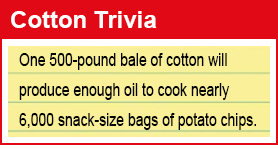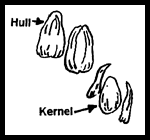The Story of Cotton – Cotton Seed
Cottonseed mills, in the late 1800’s, used manual powered mechanical pressure to squeeze the oil from the seed. This was very labor intensive and at best recovered only one-half the oil contained in the seed. Today’s mills are either screw press or solvent extraction types. The oil is removed from the meats leaving only 1-2 percent oil in the meats. With the production of 790 lbs. of cottonseed per bale of cotton lint, modern mills can extract 140 pounds of cottonseed oil. This essentially doubles the oil production efficiency of the older mills.
 Processing of cottonseed in modern mills involves a number of steps. The first step is its entry into the shaker room where, through a number of screens and air equipment, twigs, leaves and other trash are removed. The cleaned seed is then sent to gin stands, similar to those in cotton saw gins, where the linters are removed from the seed (delinted).
Processing of cottonseed in modern mills involves a number of steps. The first step is its entry into the shaker room where, through a number of screens and air equipment, twigs, leaves and other trash are removed. The cleaned seed is then sent to gin stands, similar to those in cotton saw gins, where the linters are removed from the seed (delinted).
This linter removal process is usually done twice and the fibers are collected and pressed into 600 pound bales. The linters of the highest grade, referred to as first-cut linters (longer more resilient fibers) are used in manufacturing non-chemical products, such as medical supplies, twine, and candle wicks. The second-cut linters (short fibers or fuzz), removed in further delinting steps, are incorporated in chemical products, found in various foods, toiletries, film, and paper.
 The delinted seeds now go to the huller. The huller removes the tough seed coat with a series of knives and shakers. The knives cut the hulls (tough outer shell of the seed) to loosen them from the kernels (the inside meat of the seed, rich in oil) and shakers separate the hulls and kernels. The kernels are now ready for oil extraction and the hulls are sent to storage to be sold for livestock feed. Some industrial uses for hulls have been developed and are being tested. A plastic containing hulls as a major ingredient has been used in producing small parts for textile machinery. Hulls are often incorporated in the mud used in oil well drilling. They are also used in the production of synthetic rubber and in petroleum refining.
The delinted seeds now go to the huller. The huller removes the tough seed coat with a series of knives and shakers. The knives cut the hulls (tough outer shell of the seed) to loosen them from the kernels (the inside meat of the seed, rich in oil) and shakers separate the hulls and kernels. The kernels are now ready for oil extraction and the hulls are sent to storage to be sold for livestock feed. Some industrial uses for hulls have been developed and are being tested. A plastic containing hulls as a major ingredient has been used in producing small parts for textile machinery. Hulls are often incorporated in the mud used in oil well drilling. They are also used in the production of synthetic rubber and in petroleum refining.
The meats (kernels) are now prepared for oil extraction. They pass through flaking rollers made of heavy cast iron, spinning at high speeds. This presses the meats into thin flakes. These flakes then travel to a cooker where they are cooked at 170 degrees F to reduce their moisture levels. In screw press mills, the kernels flow directly into a press which has a screw or worm gear revolving inside a horizontal steel barrel. This meat grinder type action exposes the flakes to extremely high pressure, 10 to 12 tons per square inch, forcing 96% of the oil from the meats. In the solvent extraction mills, the cooked meats are flaked to about the thickness of paper and exposed to live steam and high pressure. This action ruptures the oil cells making the oil accessible for the solvent extraction process.
The prepared meats are conveyed to the extractor and washed with hexane (organic solvent that dissolves out the oil) removing up to 98% of the oil. This hexane-oil mixture is called miscella. The miscella is pumped out of the extractor and is distilled by boiling the hexane from the mixture and condensing it with cooling water. The hexane is reused over and over again. The crude cottonseed oil is then ready for further processing and the de-oiled meats are subjected to live steam for removal of residual hexane. The meats are then dried and ground to produce a 41% protein livestock feed, called cottonseed meal. Cottonseed meals’ major value is the high protein it contains to build muscle, nerve, blood and hair. A small amount of cottonseed meal is used for fertilizer. Its organic matter improves soil texture and reduces watering needs.
Crude cottonseed oil requires further processing before it may be used for food. The first step in this process is refining. With the scientific use of heat, sodium hydroxide and a centrifuge (equipment used to separate substances through spinning action), the dark colored crude oil is transformed into a transparent, yellow oil. This clear oil may then be bleached with a special bleaching clay to produce a transparent, amber colored oil. Upon further processing, the oil is deodorized or treated so it will remain clear and have no unwanted flavors.
Cottonseed oil is used in several products. Depending on its stage of refinement, it can be used in snack foods, mayonnaise, margarine, baking or frying oils, explosives, cosmetics, rubber, soap, insecticides and many other products. Foodstuff cottonseed oil has superior nutritive qualities and is on the American Heart Association’s list of “okay foods”.
Although fiber is the most valuable product from a cotton field, it is important to remember that this versatile plant also provides many products for human and animal consumption. It is from this perspective that cotton becomes a food crop.
 We have done all the research for you…gathered supplemental literature books, videos and CD’s, and offer a variety of resources to be used in conjunction with your study unit. So let’s get started on our cotton’s journey and learn more about this useful, resourceful and magical plant we take for granted…COTTON!
We have done all the research for you…gathered supplemental literature books, videos and CD’s, and offer a variety of resources to be used in conjunction with your study unit. So let’s get started on our cotton’s journey and learn more about this useful, resourceful and magical plant we take for granted…COTTON! ![]()

